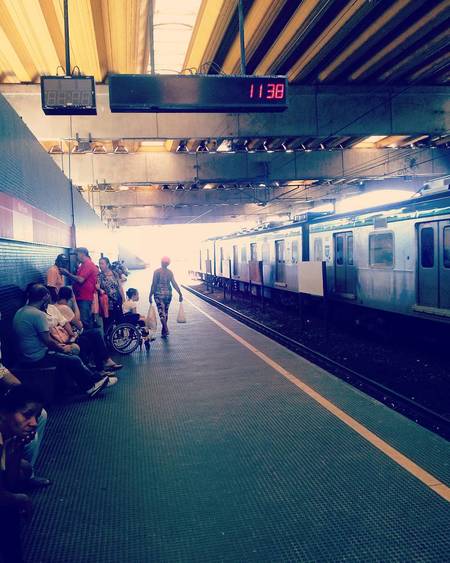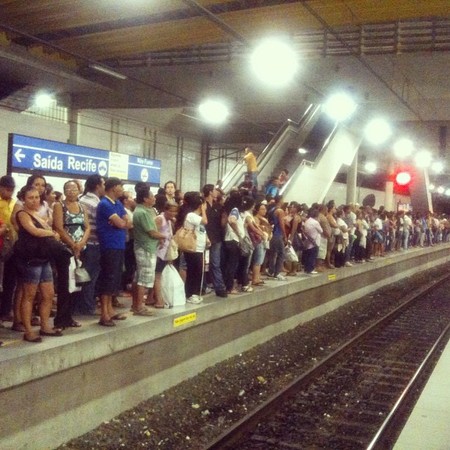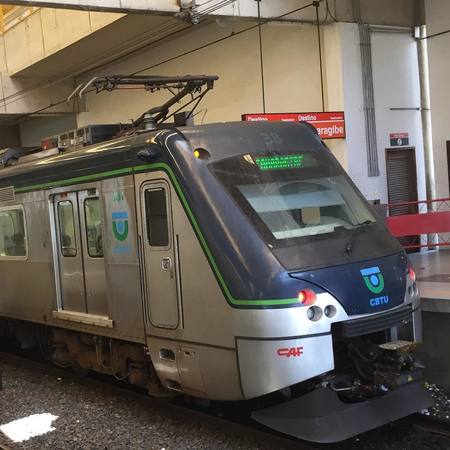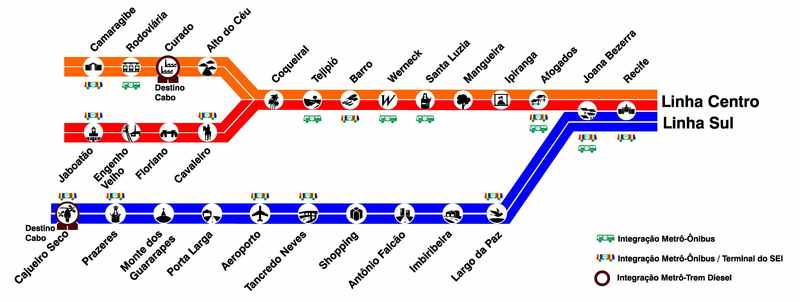The Recife Metro known as MetroRec is a subterranean public transport system that provides its service in the Brazilian city of Recife. At present, this system has a total of 29 stations in five railway lines that have a total length of 71 kilometers, including the VLT system, which is superficial and similar to a light rail metro. If only the subway itself is considered, it has a total length of 39.5 km of track distributed along three lines.
It is a relatively recent metro system, at least in the Brazilian context, as it was inaugurated in 1985. Construction began three years earlier. In addition to connecting different points of Recife, the system links the city with different nearby suburbs in the state of Pernambuco. The system has received several expansions, the most recent of them in 2013 and more are already under planning. The basic entrance fee to the Recife Metro costs R$1.60 (about $0.42 USD). The system opens at five in the morning and closes at eleven at night.
Metros in Brazil: Recife
About the city
Recife is a city located in the state of Pernambuco, to the northeast of the Republic of Brazil. It is a city surrounded by water. It is located on the coast of the Atlantic Ocean, and built over a pluvial plain. Most of the city is built on islands, islets and mangroves, so it is considered by many as the Brazilian Venice. Together with its suburbs, they form the fourth largest urban agglomeration in Brazil, surpassed only by São Paulo, Rio de Janeiro and Belo Horizonte.
It has more than four million inhabitants, making it the most populated in the entire northeastern region (and ninth in all of Brazil). The economy of this city is vibrant and quite large, hosting various important companies, many of the oil industry. There are several federal institutions as well, and different consulates of many countries around the globe.
The city is also known for its rich and eventful history, as it was the capital of the Dutch colonial attempt in Brazil between 1630 and 1654. Most of this historical heritage is reflected in the center of the city. Tourists go to Recife for the many different attractions it offers, including important events such as the Carnival of Recife and Olinda.
Transportation
The Recife Metro is an urban transport system that connects strategic points around this important city. In addition to the underground metro, which has three lines, it is complemented by a light rail system with two lines. In total, this metro system has 29 stations distributed along its 71-km route. Only 39.5 kilometers of those belong to the underground metro, though.
 Estacao Afogados
Estacao Afogados
As expected from the different tracks it has, this metro has a varied fleet, from different manufacturers. The original rolling stock was made by a consortium between the Brazilian Santa Matilde and the German Man AG: the model 800, which still circulates on the railroad tracks of the metro. Some newer trains were incorporated in 2012 and 2013: model 7500 from the Spanish CAF and Mobile 3 model from Brazilian Bom Sinal and German Voith.
About 600 thousand people ride the metro daily. The operator is Companhia Brasileira de Trens Urbanos (Brazilian Company of Urban Trains, or CBTU), which is dependent on the Ministry of Cities of the federal government.
- Known as: Metro or Metrorec
- System length: 71 km in the combined system, 39.5 km from the metro
- Track gauge: 1600 mm, 1000 mm in the VLT.
- Number of lines: 5, 3 lines from the metro
- Number of stations: 29
- Maximum operating speed: 80 km/h
- Website: portal.metrorec.com.br
- Operated by: Companhia Brasileira de Trens Urbanos (CBTU)
- Daily ridership: about 600,000 people
- Inaugurated: February 22nd, 1984, but operations commenced on March 11th, 1985.
Brief history
As with any large city, Recife had the need to develop an efficient public transport system that could handle the large amount of people and connect different points of the city. Like other Brazilian cities, it was in the 1980’s that the original project began development. The federal government created the Metrorec consortium in September of 1982, and construction of the system began in January of 1983.
The CBTU went on to replace the Metrorec consortium and was constituted on February of 1984 as a mixed company tasked with the order to modernize, expand and implement several passenger rail transport systems in Brazil. The Recife Metro began operations on March 11th, 1985.
 recife Metro
recife Metro
Once the first phase was completed, the system began to expand, largely due to the absorption of other existing train lines and infrastructure that connected Recife with the suburbs and that belonged to the RFFSA. One of the largest expansions of the system started in 1998. It electrified the southern line and extended the central line. In 2013, the diesel line was reconverted to the VLT light rail system, and a station was added to the central line.
Lines and stations
The metro in Recife has 5 different lines. 3 of them make up the actual metro part, while the other 2 are light rail trains known as VLT (Veículo Leve sobre trilhos, literally: light vehicle on rails). There are 29 stations in the system, each with its own particularities. Lines in the metro of Recife are not classified by number, and instead receive a name based on the area they serve. They are:
Central Line 1
This is one of the branches that make up the Central Line, the original section of the Recife Metro. Like the other metro lines, it departs from the Recife station, near the coast in the northern part of the city. It serves 15 stations, and covers a distance of 18.3 kilometers. It commences in Recife station, and follows its route through Joana Bezerra, Afogados, Ipiranga, Mangueira, Santa Luzia, Edgar Werneck, Barro, Tejipió and Coqueiral stations. In this last station there is a bifurcation. The Central Line 1 continues to Alto do Céu, Curado, Rodoviária, Cosme e Damião and finally arrives at Camaragibe.
It takes about 28 minutes to go from one end to the other. The first section of this line was inaugurated in 1985, later expanded in 1986 (up to Rodoviária). The last extension made it up to Camaragibe, and was finalized in 2002. This line is identified with the color orange.
Central Line 2
This line is a byproduct of the bifurcation on the Central Line. It shares the route of the Central Line 1 from Recife to Coqueiral, and then takes its own path towards Cavaleiro, Floriano, Engenho Velho and Jaboatão stations. In total, this line has 14 stations distributed along 16 kilometers of track. The trip between its two terminals takes about 26 minutes. The extension from Coqueiral to Jaboatão station was completed in 1987. It is identified by the color red.
South Line
Known as Linha Sul in Portuguese, it covers a distance of 14.3 kilometers, passing through 12 stations along its way. The trains take about 22 minutes to cover its entire length. As with the other metro lines, it begins at Recife station. It then continues to Joana Bezerra and parts from the shared line towards Largo de Paz. It then passes through Imbiribeira, Antônio Falcão, Recife Shopping Center, Tancredo Neves, Aeroporto, Porta Larga, Monte dos Guararapes, Prazeres and Cajueiro Seco. This line was inaugurated on February 28th, 2005 with a route between Recife and Imbiribeira. It was until March of 2009 that it was extended to Recife Shopping Center. It was further expanded in February of 2010, reaching Tancredo Neves. The last extension was finished in August of 2010, up to the current terminal of Cajueiro Seco. The color of this line is dark blue.
Cajueiro Seco-Cabo Line (VLT)
This is one of two superficial light rail lines that are managed by the Recife Metro. It already existed when planning for the metro started, but it was run independently from the metro until 1988, when Metrorec took over and gave it the route it has today, diverting it to Cajueiro Seco so it could connect with the future South Line. This section suffered an important transformation in 2010, when it was reconverted to the modern VLT system. It has a total of six stations along a 15.5-km route that takes about 42 minutes to travel. The stations are Cajueiro Seco, Ângelo de Souza, Pontezinha, Ponte dos Carvalhos, Santo Inácio and Cabo. The color that identifies this line is green.
Curado-Cajueiro Seco Line (VLT)
It is the other line that was reconverted into VLT. It originally linked the cities of Recife and Maceió. It was absorbed by the Metrorec in 1988 and diverted to the Cajueiro Seco station so it could connect with the future South Line. It has a total length of about 18.4 kilometers along its four stations, which can be covered in approximately 31 minutes. This line heads towards the north of the city near its outer rim. The stations served by this line are: Curado, Jorge Lins, Marcos Freire and Cajueiro Seco. The color linked with this line is gray.
Schedule and timetables
Unlike other transport systems, the Recife Metro operates under rigid schedules, which do not vary significantly between lines. In the case of Central Line 1, Central Line 2 and South Line, it operates from five in the morning until eleven at night in an uninterrupted manner. Central Lines 1 and 2 have a frequency between trains of 4 to 7 minutes, depending on the time of the day. On the other hand, for the South Line, the interval between trains is always 8 minutes, regardless of demand.
The VLT lines operate differently. The schedule is not the same as the conventional metro. In the case of the Cajueiro Seco-Cabo line, the first train departs from Cabo station at 5:21 in the morning, while the last one leaves Cajueiro Seco at 8:47 at night. This happens on weekdays, Monday through Friday. On Saturdays, the system is open until 3:15 in the afternoon. The frequency of this line is rather low, as it starts from about an hour between trains to a forty-minute wait between trains the rest of the day.
The Curado-Cajueiro Seco line begins operations at 5:49 in the morning from the Cajueiro Seco station. The last train leaves Curado at 8:31 in the evening. On Saturdays, the last train leaves this same station at 2:13 in the afternoon. The frequency of this section of the Recife Metro is very low, as there are almost two hours between trains in the morning, reducing somewhat during rush hours and increasing again in the afternoon.
Tariffs, tickets and cards
The prices on the Recife Metro are quite simple. Users have the possibility of accessing through the purchase of a simple ticket, which will allow them to travel throughout the entire system without a time or distance limit. The cost of this ticket is R$1.60 (about $0.46 USD). However, there are other options to choose from, including the possibility to combine metro and buses through integrated tickets.
All passengers may buy integrated tickets should they desire to do so. They both serve the same purpose, but vary according to the distance the user will travel. The first ticket covers all stations within a ring, identified by the letter “A”, and has a cost of R$2.15 ($0.56 USD). The second ticket allows for further travel distance, and encompasses all stations within ring “B”. This ticket costs R$3.25 (about $0.85 USD)
 Recife Metro Station
Recife Metro Station
Connections with other systems
A city of the magnitude of Recife needs several transport systems of different types to connect all its areas. That is why the Recife Metro has many connections with a large bus network managed by at least 18 different companies. In total, all of them handle an approximate 4800 buses that circulate around the city. They are all governed by a public entity called Grande Recife Consórcio de Transporte.
Some of the stations that have bus terminals are Recife, Joana Bezerra, Afogados, Santa Luzia, Edgar Werneck, Barro, Tejipió, Cosme e Damião, Camaragibe, Jaboatão, Largo da Paz, Tancredo Neves, Aeroporto, Prazeres, Cajueiro Seco and of course, the Rodoviária station. From this last station, you can take buses that go to most areas within Brazil.
In addition to the bus system, the transport consortium also manages the BRT Via Libre, a bus rapid transit system that has two road corridors in the city and was inaugurated in 2014. The first corridor runs along a North / South axis. It handles about 66 thousand users per day and has 25 stations. This corridor connects the municipalities of Igarassu, Abreu e Lima, Paulista and Olinda with Recife. There is also the East / West corridor, which serves more than 50 thousand users per day throughout its fifteen stations. One of them, Camaragibe, is also the terminal station of Central Line 1 of the Recife Metro.
Connections to the airport
The air terminal that handles the flights in and out of Recife is the International Airport of Recife/Guararapes, also known as Gilberto Freyre. It is located in the municipality of Jaboatão dos Guararapes and is the busiest airport in the entire Northeast region. It is located relatively close (12 kilometers) to the city. The metro connects directly to the terminal, and access is very simple, as it is linked through a passenger bridge to the Aeroporto station of the South Line.
Future expansions
Since the last expansion of the system in 2010, the Recife Metro has focused primarily on the modernization of its facilities and existing systems, much like the VLT lines project. However, there are several plans to continue the expansion the system. One of the main projects is a proposed extension of 11 kilometers, connecting different VLT systems in the municipality of Ipojuca. Thus, one could expect the main focus for the short term is the expansion and development of the VLT light rail lines throughout different areas of the city and that are connected to the existing subway lines.
Advice
-
Like many public transport systems, it is always advisable to keep in mind some basic tips to make the trip as pleasant as possible and to be safe. Referring to the Recife Metro, some of those are:
- While the pricing system is very simple, you should pay attention if you are going to buy an integrated ticket (those that are also valid for the bus lines), because the fare is different depending on the distance you intend to travel.
- It is important to note that the system has a regular schedule throughout the weekdays, but a significantly shorter operating time on Saturdays. Take this into consideration when planning your trip around the city.
- If you are taking the metro to or from the airport, it is advisable not to travel with too much luggage, as it can be a nuisance for other passengers.
Fun facts
Any transport system has peculiarities that can be particularly interesting for many who travel in them frequently. The Recife Metro is not an exception and has many curious things. Some of them are:
- Due to the high rate of illiteracy in the region, that exceeded 10.55% in the year 2000, the Recife Metro implemented a pictogram system that helped those unable to read to identify each of the stations. This way, the use of the system was made easier for people with this problem, as they could now easily know when to get off the trains.
- It was the third metro system in Brazil, after Sao Paulo and Rio de Janeiro.
- It has different train systems working together: a conventional metro, a former diesel line and two light rail lines.
Tourism and sightseeing
Recife is a coastal city and has many rivers and smaller bodies of water. This is part of what makes it attractive for tourists from all around the globe. It is one of the most popular destinations in Brazil. The islands and smaller islets have become important attractions of the city. In addition, Recife has a rich history that can be easily discovered in many places throughout the historic center of the city. The economic influence that Recife has over the Northeastern region has also resulted in a recognizable skyline. Some of the most visited places that can be easily reached via the Recife Metro are:
Museum of the city of Recife – Fort of the five points: this museum is located just a few blocks to the south of the Recife station. It was installed inside the Forte de São Tiago das Cinco Pontas. This is a Portuguese stone building that rises above the old Dutch fort constructed before it. This is one of the main historical museums of the city, constantly hosting exhibitions and events about Recife's past.
National Historical Park of the Guararapes: this 3.6 square kilometer park is located in the Jaboatão dos Guararapes municipality. Inside the park is the Morro de los Guararapes, an elevation known for being the central area of the battle of the Gurararapes, which resulted in the defeat of the Dutch and their banishment from the city. To get there, passengers must get off at Porta Larga station, or at the Monte dos Guararapes station, which is even closer. Both stations are served by the South Line.
Desert Dock Museum (Cais do Sertão): near the Recife station is one of the newest museums, having been inaugurated in 2014. It is a thematic museum dedicated to the region of the Sertão, a semi-desertic region in the Northeast that has deeply rooted musical and social traditions. The museum has many references to the figure of Luiz Gonzaga, a famous singer who was one of the greatest exponents of the baião genre.
Recife metro map
- Passengers/Day 210000
- Fares:
- 24h operation: No
- Air Conditioning: No
- Walk between platforms: No
- Driverless trains: No
- Screen Doors Platforms: No
- Max. Speed: 50km/h
- Operator: Superintendência de Trens Urbanos de Recife
- Â R $ 2.45
- Recife Metro Official Website
Help us
If you consider that the information we provide is wrong, not accurated, outdated, translation contains errors, and you would like to help us to improve the file...you can contact us here.
Feel free to contact us if you dont find the system you're looking for and we'll add it as soon as we can!
Thank you very much!







